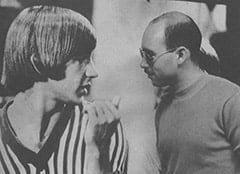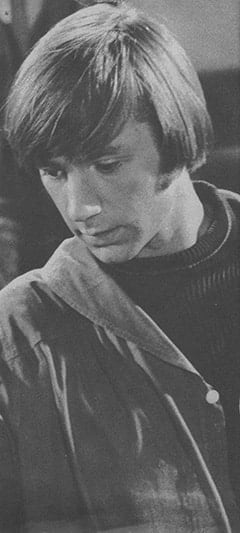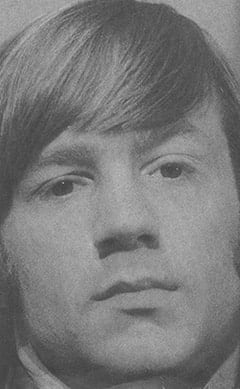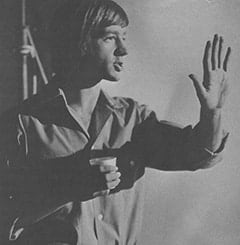
By Steve Pope, Peter’s Best Friend in College
In September, 1959, Peter H. Thorkelson entered Carleton College in Northfield, Minnesota. Steve Pope was a member of that same freshman class, and was graduated from Carleton in June, 1963. Peter, of course, never graduated, having already decided that music meant more to him than anything else in the world. But, during the two years that Peter did attend Carleton, his best friend on campus was “Poper”—Steve Pope, who shared all of Peter’s happy and unhappy times. In an exclusive series beginning in this issue of FLIP, Steve will take you through these exciting years of Peter’s life.

I’d just moved into Carleton’s freshman dorm, when I saw Peter for the first time. Wearing short hair, looking very puckish and plucking on one of his oldest banjos, there he was—in one of his most familiar poses. I was to see Peter often like this. It seemed as if that banjo never left him!
We weren’t introduced yet, but a couple of days later I found out that we were in the same math class together and that Peter’s room was just down the hall from mine. Soon, I was introduced to Peter H. Thorkelson, beginning a friendship with Peter which lasted even long after he eventually left Carleton.
Funny about that name. You’d never think that there could be two Peter Thorkelsons in any one place at the same time. But there were actually two Peter Thorkelsons in my freshman class. The only difference was their middle initials and the fact that Peter pronounced the first part of his name “TORK” while the other pronounced his “Thork.” Peter usually used his middle initial to keep their identities separate.

Right away, I knew that Peter was OK. Sophomores at Carleton haze the freshmen, but Peter would have no part of it from the start. Like, for instance, he refused to wear the beanie that all freshmen were supposed to wear to show the world their inferior status. Then, as always, Peter kept his cool!
I got to know Peter’s room down the hall from mine very well. Banjos and guitars were hanging all over the walls. (But this room was nothing compared to the room Peter would have during his sophomore year! Which I’ll talk about when I get to that period of Peter’s life.)
The reason I got to know Peter’s room so well is that he loved to stay up all night to talk about philosophy and politics, and those of us who shared Peter’s thoughts usually did so in his room. There he would talk about anything that came to his crowded and creative mind. In old faded Levis, wearing a straight T-shirt (for some reason, during his freshman year, Peter always wore faded blue-and-white horizontally-striped T-shirts), with his banjo nearby, Peter would talk… and talk… and talk.

By the time Pete would be finished talking, you were convinced that what he was saying was right. He was (and still is) a very convincing talker whose arguments and thoughts would fall nicely together as he developed them.
When it came to girls, however, Peter would often let his banjo do the talking. Playing love songs and ballads, he was an outgoing and popular date. As I remember, he dated very sweet and pretty girls and he used to frequently fall in love. But that’s a natural extension of Peter because he’s a very loving-type person. Yet, in his own way, he was shy… if you can imagine someone being shy and outgoing at the same time.
About the only place where Peter didn’t take his banjo was class, when he went to class. When he did attend classes, he usually went barefooted. All the teachers and professors thought that he was tremendously intelligent, but they would get mad at him because he wouldn’t study. He’d get “A’s” on all his papers, and then ruin all his brilliance by not studying for the final.
Peter was already beginning to feel that he wasn’t getting anything out of his formal education. He believed that he was getting more knowledge from our conversations and bull sessions than he was getting from all his classes. But he promised himself that he wouldn’t decide whether or not he would come back to Carleton until after the summer.

That summer, I worked in an orchard near my hometown of Downington, Pennsylvania, and Peter made the first of his many trips to Greenwich Village in New York. When school was over, we promised each other to keep in touch and meet again (maybe) in the fall up at Carleton.
So, you can imagine my surprise when one night in the middle of the summer, around 10 o’clock, the telephone rang and I heard a familiar voice: “I’m here, Poper… next to the Chevron station… in Paoli.”
When I got to the station, there was Pete, with a hamburger in one hand and a banjo in the other. And, for the next two days, we both got very little sleep.

We talked a lot, as ever, and set up a Dixieland band which played… and played… and played. Peter serenaded my little sister, Janet, who was 12 then, with all sorts of happy songs, like “Inky Dinky Spider.” And we drove around a lot, enjoying the beautiful countryside, which Peter appreciated as much as I did.
He told me that he hadn’t made up his mind about whether he’d come back to school. And he was restless and anxious to move on.

So, I took him to the Pennsylvania Turnpike entrance, from where he hoped to hitch-hike to the midwest. As I looked back, there stood Peter—his shirt sticking out, a big old leather flight bag which was bulging in one hand, and his banjo in the other…
In the November issue of FLIP, on sale September 7th, Steve will continue his exclusive series MY COLLEGE DAYS WITH PETER TORK. Don’t miss it! Reserve your copy of the next outasite issue of FLIP today!



